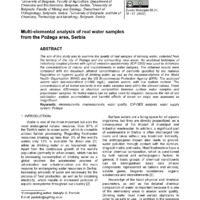Multi-elemental analysis of real water samples from the Požega area, Serbia
Објеката
- Тип
- Рад у часопису
- Верзија рада
- објављена верзија
- Језик
- енглески
- Креатор
- Nebojša Pantelić, Jana Štrbački, Ivana Maloparac, Nikola Tomašević, Biljana Dojčinović, Aleksandar Kostić
- Извор
- Zastita materijala
- Издавач
- Inženjersko društvo za koroziju
- Датум издавања
- 2022
- Сажетак
- Cilj ovog rada bio je ispitivanje kvaliteta realnih uzoraka vode za piće, prikupljenih sa teritorije grada Požege i okolnih seoskih naselja. Za određivanje koncentracije makro i mikroelemenata u uzorcima vode korišćena je analitička tehnika induktivno kuplovana plazma sa optičkom emisionom spektrometrijom, ICP-OES. Dobijeni rezultati upoređivani su sa maksimalno dozvoljenim kocentracijama elemenata propisanim nacionalnim Pravilnikom o higijenskoj ispravnosti vode za piće, kao i preporukama Svetske zdravstvene organizacije (WHO) i Američke agencije za zaštitu životne sredine (EPA). Analizirane vode su malomineralizovane (<1000 mg/L), kalcijumskog tipa i sa niskim sadržajem natrijuma. Sadržaj svih ispitivanih elemenata u uzorcima vode bio je u granicama dozvoljenih vrednosti. Konstatovano je da postoje očigledne razlike u makro i mikrokomponentnom hemijskom sastavu između uzoraka površinske vode i uzoraka podzemne vode. Ispitivane vode mogu bezbedno da se koriste u meliorativne svrhe, jer je rizik od zasoljavanja zemljišta, nagomilavanja natrijuma i štetnog uticaja bora na biljne kulture procenjen kao neznatan.
- The aim of this study was to examine the quality of real samples of drinking water, collected from the territory of the city of Požega and the surrounding rural areas. An analytical technique of inductively coupled plasma with optical emission spectrometry (ICP-OES) was used to determine the concentrations of macro- and microelements in water samples. The obtained results were compared with the maximum allowed concentrations of elements specified by the national Regulation on hygienic quality of drinking water, as well as the recommendations of the World Health Organization (WHO) and the US Environmental Protection Agency (EPA). The analysed waters were low-mineralized (<1000 mg/L), calcium waters, with low sodium content. The concentrations of all tested elements in the water samples were within the allowed values. There were obvious differences in chemical composition between surface water samples and groundwater samples. All tested waters can be safely used for irrigation, because the risk of soil salinization, sodium accumulation and harmful effects of boron on crops was assessed as insignificant.
- том
- 63
- Број
- 1
- почетак странице
- 58
- крај странице
- 67
- doi
- 10.5937/zasmat2201058P
- issn
- 0351-9465
- Subject
- General Materials Science
- Шира категорија рада
- M20
- Ужа категорија рада
- М24
- Права
- Отворени приступ
- Лиценца
- All rights reserved
- Формат
- Медија
 Pantelic et al. 2022.pdf
Pantelic et al. 2022.pdf
Nebojša Pantelić, Jana Štrbački, Ivana Maloparac, Nikola Tomašević, Biljana Dojčinović, Aleksandar Kostić. "Multi-elemental analysis of real water samples from the Požega area, Serbia" in Zastita materijala, Inženjersko društvo za koroziju (2022). https://doi.org/10.5937/zasmat2201058P М24
This item was submitted on 9. децембар 2022. by [anonymous user] using the form “Рад у часопису” on the site “Радови”: http://romeka.rgf.rs/s/repo
Click here to view the collected data.